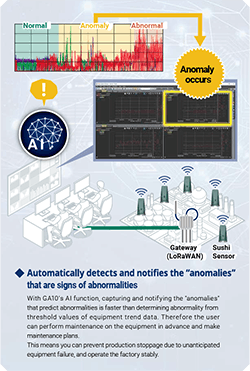Yokogawa announces the release in North America of its Sushi Sensor, an OpreX Asset Management and Integrity wireless offering with advanced AI analytics via GA10 software that suits IIoT plant asset management (PAM) applications. The offering provides efficient and effective online collection of equipment data across industrial facilities via wireless sensors for early equipment failure detection. The Sushi Sensor combined with AI GA10 software transforms a reactive maintenance process to one which is proactive, intelligent and condition-based, according to the company.
Oil and gas facilities lose up to 10% of annual production every year as a result of unplanned downtime, according to a 2016 study by ARC Advisory Group. Nearly 30% of senior executives, engineering, operations and maintenance managers surveyed by ARC reported between 3-5% lost production every year from unscheduled downtime. The cost of equipment failure significantly impacts return on capital employed (ROCE) performance through lost revenues, high operating and maintenance costs (OPEX) and unnecessary capital cost (CAPEX) for remedial work, modifications and upgrades. More predictive and prescriptive asset management strategies are required to exploit the benefits of applying data and analytics to maintenance.
The Sushi Sensor, with LoRaWAN (long range wide area network) communication technology and advanced analytics from GA10 software, enables the digital transformation of rotating equipment asset management. Approved by testing and standards agency, FM Approvals, for operation in hazardous areas, the Sushi Sensor is a compact wireless device providing online vibration and surface temperature measurement in machines and process equipment. Via LoRaWAN, a low power, wide area network with up to ten times the range of other IoT wireless networks, the Sushi Sensor efficiently communicates digitized measurements to Yokogawa’s AI analytics environment. The product offers easy installation/setup, excellent environmental resistance and monitoring versatility via on-premise servers or the Cloud, according to Yokogawa.





